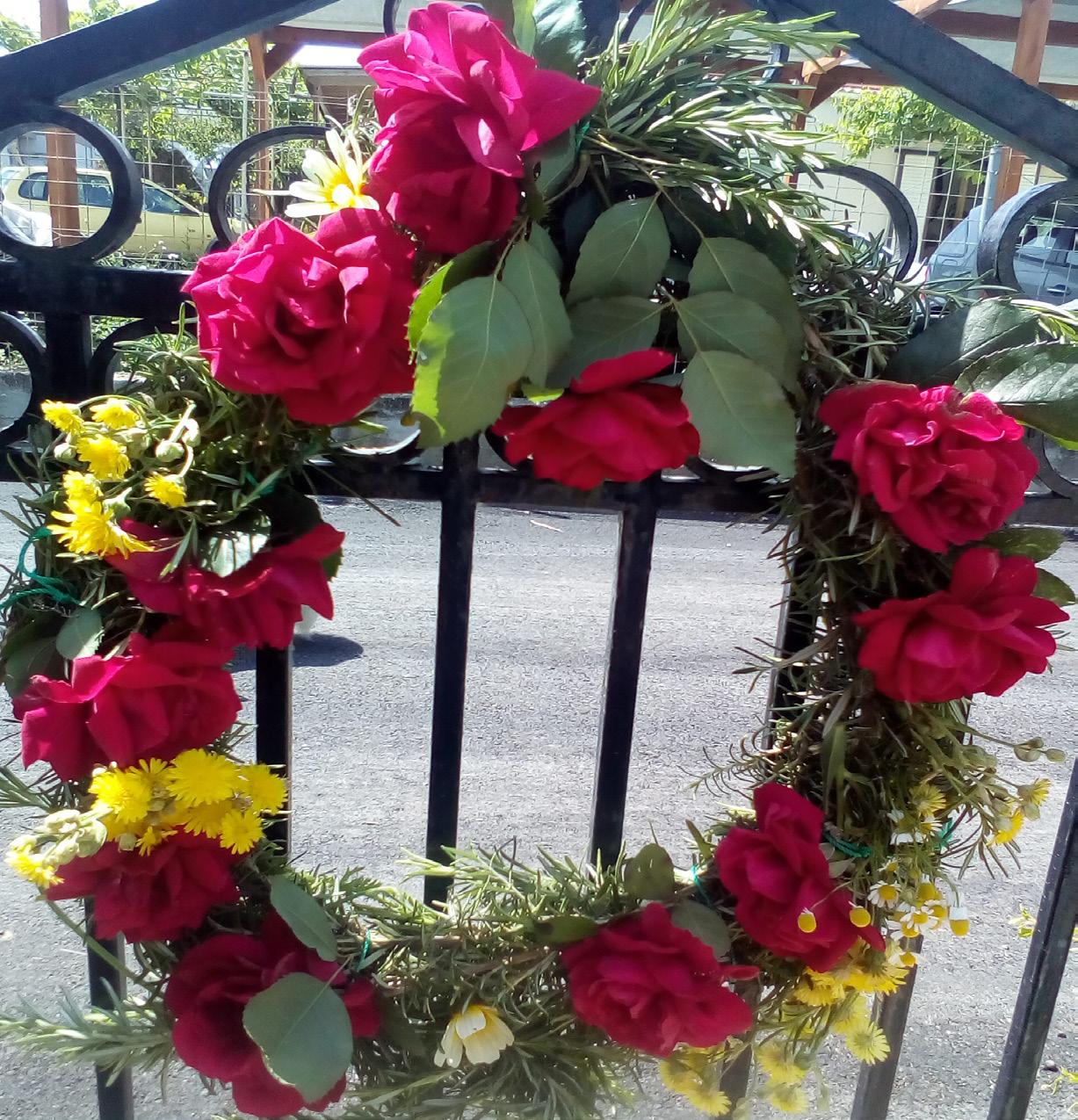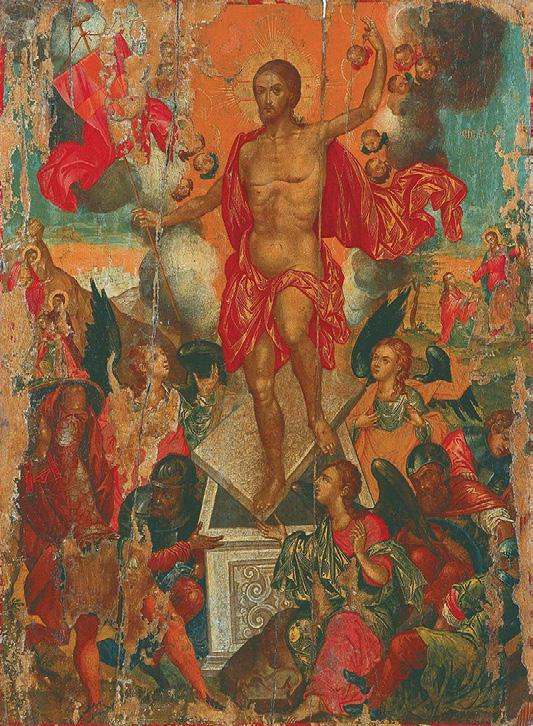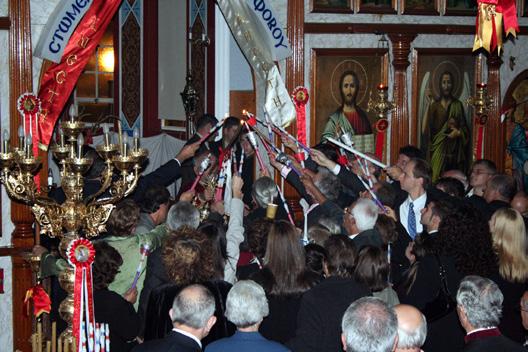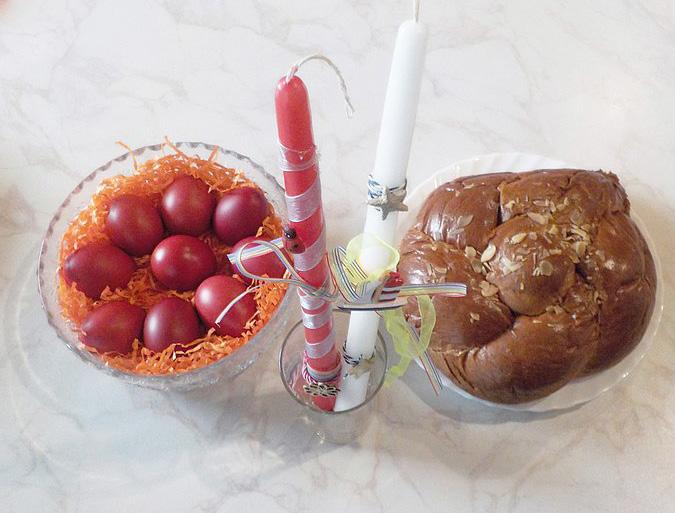
7 minute read
Greek Culture: Spring Holidays
Story and photo by Kostas Fantaousakis, Public Affairs
May 1 - May Day: A Flowery Holiday For Greece
Advertisement
May 1, known as “Protomagia” (May Day) in Greece, is a combination of a traditional Greek holiday and Labor Day.
May, according to Greek folklore, has two meanings: The good and the bad; and rebirth and death. The custom is to celebrate the final victory of summer over winter, as the victory of life over death. This day was also dedicated to the goddess of agriculture, Dimitra, and her daughter, Persephone, who on this day, according to ancient tradition, emerge from the underworld and come to earth, marking the blooming of nature and the birth of summer.
According to some historians, “Protomagia” has its roots in “Anthestiria,” a celebration in honor of Dionysos, the Greek god of theater and parties, with a festival of souls, plants and flowers celebrating the rebirth of man and nature.
Traditionally, in years without the restrictions of the COVID-19 pandemic, every major municipality organizes events featuring flowers and outdoor activities to commemorate the day, and local festivals are common.
Due to these rich traditions, the flowery part of the holiday is also very popular for Greek families as it is related to the peak of the flower season. The main thing that characterizes “Protomagia” is the massive exodus of people out of the city and into the countryside. Picnics are organized with family members and friends.
One common custom throughout Greece is making a wreath known as “the wreath of May” and hanging it on the main entrance door. This is a very fun activity, especially for children, when they are out in the country in touch with nature and picking flowers for the wreath.
The wreath stays on the door until June 24, the day of the Nativity of John the Baptist, also known as ”Klidonas,” meaning sign or oracle. It is customary on this day to burn the wreaths of May in large communal bonfires, accompanied by music, dancing and jumping over the flames.
The labor-related holiday is called “Ergatiki Protomagia,” which literally means Workers' 1st of May. Celebrations are marked by demonstrations in which workers' unions participate and major strikes are sometimes scheduled for this day. Due to COVID-19 measures, May Day celebrations are unlikely to take place this May Day. This year, May 1st falls on the same day as Good Saturday during the Greek Orthodox Easter celebration.
April 25 - May 1: Greek Orthodox Easter
Photos source: Wikipedia.com

An icon featuring the "Anastasis" (Resurrection). According to an inscription, this icon was painted in 1679 by the Cretan artist Ilias Moskos. Origin: Greek island of Kephallonia.
Christmas, Easter and the Assumption of Virgin Mary (Aug. 15) are considered the greatest religious holidays in Greece. Christmas ranks second to Easter, making the latter the most sacred and celebrated of all Greek holidays. The Greek word for Easter is “Pascha.”
Usually, the Eastern Orthodox Church does not celebrate Easter on the same date as the Catholic and Protestant denominations because the Orthodox Church uses the Julian calendar.
The spiritual preparation for Pascha begins with Great Lent, which starts on Clean Monday (March 15) and lasts for 40 continuous days. No meats, dairy, fish, poultry or dishes prepared with these foods can be consumed during the Great Lent.
Palm Sunday (April 25) is the first day of the Holy Week and only fish and fish courses are served. During the rest of the Holy Week complete fasting is to take place.
The fast stops immediately after the Easter Divine Liturgy (May 1), at midnight. The Holy Week ends with the commencement of the Easter celebration (Μay 2) which glorifies the Resurrection of Jesus Christ.
Every evening throughout Holy Week has its own significance and traditions:
Sweet rolls, an Easter cookie-like pastry called “koulourakia”, are baked on Holy Tuesday (April 27). In the evening, the blessing of Holy Oil takes place in church.
Holy Thursday (April 29) is the day for dying eggs. In Christianity, the egg is a symbol of resurrection, representing the emergence of Christ from His tomb to everlasting life. Greeks mainly color hard-boiled eggs red (scarlet) to signify the blood of Christ. In the evening, following the reading of the Gospel, the girls decorate the “Epitaphios”. This is a wooden representation of the Tomb of Christ (also called a bier), and is usually elaborately carved and decorated with flowers, so on Good Friday morning it will be ready to receive the body of Christ when He is taken down from the cross.
Good Friday (April 30) is a day of mourning. The drama of the death of Christ is followed with great devoutness. Vesper evening on Good Friday is followed by the procession of the “Epitaphios” representing Christ's funeral. A choir singing hymns precedes the procession; they are followed by the clergy, the altar boys carrying the liturgical fans, and the people of the region singing hymns throughout the procession. All along its route, people hold lighted candles in their hands.
On Holy Saturday evening (May 1), the “Anastasi” (Resurrection mass) will take place. The midnight service is without a doubt the most important day of the year. At midnight, all the lights are extinguished in the church and the priest comes from behind the doors on the altar carrying a candle lit with Holy Light. He walks to those standing in the front row and lights their candle and those who receive the light of the resurrection pass the light from candle to candle until the light fills the church.

The “Epitaphios”, the bier of Christ, is carried during a Good Friday service at a Greek Orthodox Church.
Everybody leaves the church after midnight, chanting the following song:
Christos Anesti ek nekron, (Christ has risen from the dead) thanato, thanaton patisas, (trampling down death by death) kai tis en tis mnimasi, (and upon those in the tombs) zoin charisamenos (bestowing life!)

People receiving the Holy Light at Easter from the priest.
At the moment of the Resurrection, families and friends exchange kisses and say, “Christos Anesti”, (Christ is risen!). The response to this wish is “Alithos Anesti” (Truly He is risen). Fireworks and a great celebration usually accompany the midnight announcement of the Resurrection of Christ. In Crete, people take home their lighted candles carefully with the holy light of the Resurrection. Before entering their houses, they make a cross with the smoke of the candle on top of the door, light the oil candle before their icon stand, and try to keep this light burning throughout the year to bless the house and its inhabitants by the light of Christ's Resurrection.
The traditional meal following the Resurrection consists of “mageiritsa”, a soup made of chopped lamb liver and wild greens seasoned with eggand-lemon sauce. Traditionally, Easter eggs, hard-boiled eggs dyed bright red, are cracked against each other to celebrate the opening of the Tomb of Christ. People crack their eggs against their friends' eggs and the owner of the last egg to remain unbroken is considered lucky. During this family gathering Greeks also eat “koulouria” (Easter cookies), “kalitsounia” (cheese or spinach pies) and “tsourekia” (Easter cakes).
Easter Sunday (Sunday, May 2)
The Greeks have many traditions on this day, but the most important is the gathering of the family and the roasting of a lamb, “Arni Pashalino tis Souvlas”

“Mageiritsa”, a soup made of chopped lamb liver and wild greens seasoned with egg-and-lemon sauce. It is consumed right after the Resurrection.

Lamb on the spit.
(Easter lamb on the spit), in their yards. The spits start turning early in the morning under the shady trees as the lamb is cooked slowly. The lamb is one of the most common Christian symbols, especially associated with Easter, and it is known as the Agnus Dei, meaning "Lamb of God" in Latin. The popularity of lamb as an Easter food is undoubtedly related to its importance as a symbol.
Another popular food of the day is “kokoretsi”, a traditional dish consisting mainly of seasoned lamb or entrails and internal organs. Recipes usually include chopped intestines, sweetbreads, hearts, lungs and/or kidneys marinated in lemon, olive oil, oregano and seasoned with salt and pepper. The small intestine is wrapped around the spit used to partially cover the meat. The “kokoretsi” is then roasted over charcoal.
Although the roasted lamb and “kokoretsi” are the main dishes, all other foods from the previous night are consumed and Easter eggs are cracked again. This feast, called the "Feast of Feasts,” goes on all day and is followed by drinking wine, dancing and singing.
Greek Easter Wishes
Greeks wish "Kalo Pascha" (Have a good Easter) when the Holy Week starts. They wish "Kali Anastasi" (Have a good resurrection) when Easter Sunday is very close, especially after Holy Thursday and Good Friday. And of course they wish "Christos Anesti" on Easter Sunday when Christ has already risen.

Hard-boiled eggs dyed bright red, resurrection celebration candles and a type of sweet brioche called "tsoureki."








